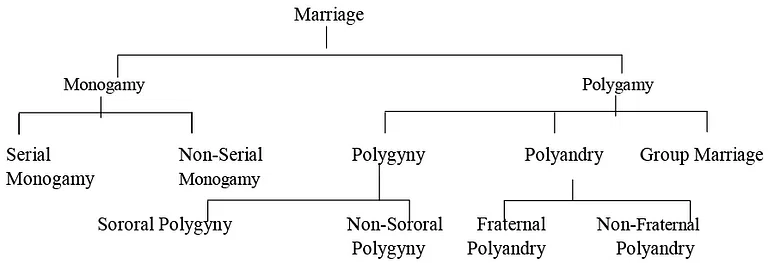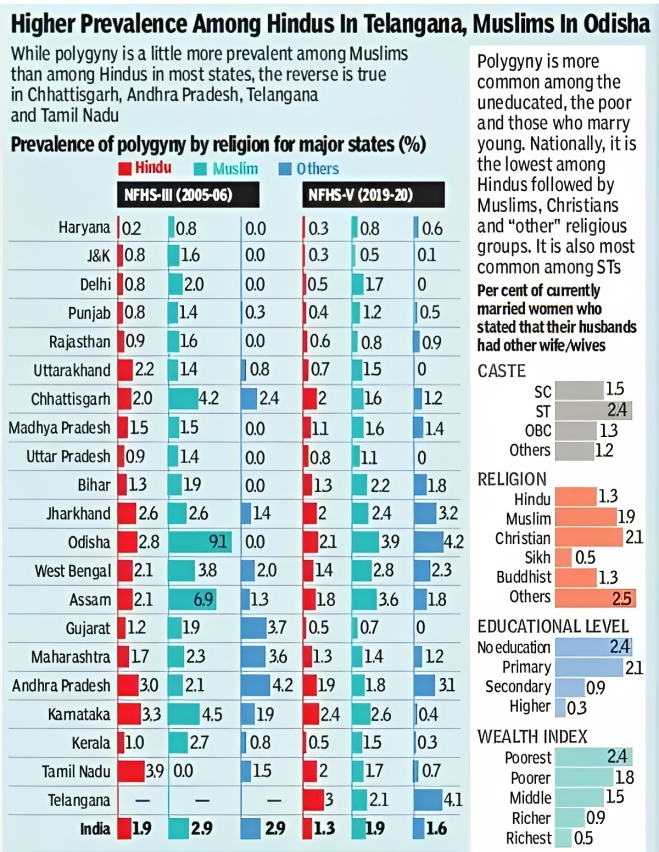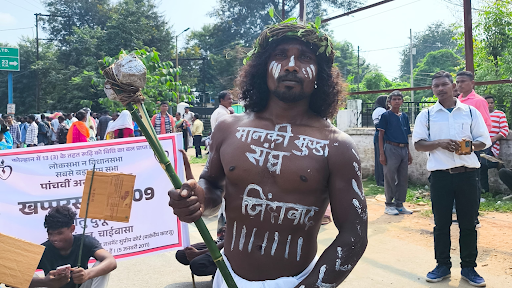Description

Copyright infringement not intended
Context: The State Government of Assam will appoint an "expert committee" to investigate whether the state legislature has the authority to prohibit polygamy. This committee will be comprised of legal professionals and academicians.
Polygamy
About
- Polygamy is the practice of having more than one spouse at the same time.
- Polygamy can be of two types:
- Polygyny, where a man has multiple wives.
- Polyandry, where a woman has multiple husbands.
- In India, polygamy is illegal for most citizens, except for Muslims and some Hindu communities in Goa and the western coast.
- The practice persists in some parts of the country, especially among the poor and uneducated sections of society.
- The legal status of polygamy in India has been a subject of debate and controversy for a long time.
- Some argue that it is a violation of human rights and gender equality and that it leads to social problems such as domestic violence, child marriage and divorce.
- Others argue that it is a matter of personal choice and religious freedom and that it has benefits such as economic security, social support and marital harmony.
- The Supreme Court of India has stated that polygyny is not an integral or fundamental part of the Muslim religion and that the state has the power to regulate it under Article 25 of the Constitution.
History of Polygamy in India
- Polygamy has a long history in India, dating back to ancient times.
- It was practised by kings, nobles and warriors as a sign of power, wealth and prestige.
- It was also practised by some religious sects and communities as a way of increasing their population and spreading their faith.
In the Pre-Colonial era
- Polygamy was not prohibited in ancient India and was common among aristocrats and emperors. However, it is believed that it was not a major cultural practice and was mostly confined to the upper classes.
- The Hindu scriptures also mention polygamy but with certain conditions and restrictions. For example, the Manusmriti, a Hindu law book, allows a man to take a second wife only if the first one is barren or suffers from a chronic disease.
- Polygamy was prevalent among Muslims, who followed the Islamic law that allowed a man to have up to four wives, provided he could treat them equally and justly.
- It was also common among Hindus, who followed the Hindu scriptures that permitted a man to have multiple wives for various reasons, such as producing a male heir, fulfilling his desires or performing his religious duties.
In the Colonial era
- Polygamy was discouraged by the British rulers, who imposed their own moral and legal codes on Indian society.
- British enacted laws that prohibited polygamy for Hindus and other non-Muslims, but exempted Muslims from these laws on the grounds of respecting their religious customs.
- They also introduced reforms that promoted monogamy as the ideal form of marriage for all Indians.
- The Indian Penal Code of 1860 criminalized bigamy (having two spouses) for all citizens under Sections 494 and 495. However, polygamy remained legal for Muslims in India, as they are governed by their laws based on the Sharia (Islamic law).
- According to the Sharia, a Muslim man can have up to four wives at a time, provided he treats them all equally and obtains their consent.
In the Post-Colonial era
- The Hindu Marriage Act 1955 was enacted, which made monogamy the norm for Hindus and banned polygamy for them, except for some tribal communities and residents of Goa. The act also provided legal recognition for divorce and remarriage for Hindus.
- Polygamy remained legal for Muslims and other minorities by the Muslim Personal Law (Shariat) Application Act of 1937, which recognized Islamic law as the source of authority for matters related to marriage, divorce and inheritance for Muslims.

Causes of Polygamy in India
- Polygamy in India is influenced by various factors, such as religion, culture, economics and politics.
Religion
- Some religions allow or encourage polygamy as a part of their doctrine or tradition. For example, Islam permits a man to have up to four wives if he can treat them fairly and provide for them adequately.
- Some Muslim men practice polygamy as a way of following their faith or fulfilling their religious obligations.
Culture
- Some cultures accept or promote polygamy as a part of their social norms or values. For example, some tribal and rural communities practice polygamy as a way of increasing their population or maintaining their lineage.
- Some rural communities in India practice polygamy as a way of coping with the shortage of women due to female infanticide or sex-selective abortion.
- Some families practice polygamy as a way of strengthening their ties or alliances with other families.
Economics
- Some people practice polygamy as a way of securing their economic interests or improving their social status. For example, some men practice polygamy because they want to have more children who can work or earn for them.
- Some poor men practice polygamy as a way of accessing more resources or sharing the burden of household expenses.
- Some women practice polygamy because they want to have more resources or security from their husbands.
Politics
- Some people practice polygamy as a way of asserting their political rights or challenging the state authority. For example, some separatist groups in India practice polygamy as a way of expressing their resistance or rebellion against the Indian government.
- Some minority groups in India practice polygamy as a way of demanding their autonomy or protection from the majority community.
Social Pressures
- Some people practice polygamy because they face social pressures or expectations from their peers or elders. For example, some men practice polygamy because they want to prove their masculinity or virility.
- Some women practice polygamy because they want to avoid stigma or isolation as widows or divorcees.
Personal Preferences
- Some people practice polygamy because they prefer it over monogamy or celibacy. For example, some men practice polygamy because they want to have variety or satisfaction in their life.
- Some women practice polygamy because they want to have companionship or support from other co-wives.
Consequences of Polygamy in India
For Women
- For women, polygamy often means a lack of autonomy, dignity and security.
- They have to share their husband's attention, resources and affection with other wives, which can lead to jealousy, conflict and violence.
- They also face a higher risk of domestic abuse, sexual exploitation, reproductive health problems and mental stress.
- Polygamous women have lower status and power in their families and communities and are often denied their rights to education, property and inheritance.
For Children
- For the children, polygamy can result in neglect, deprivation and discrimination.
- They may not receive adequate care, nutrition and education from their parents, especially if they belong to a less favoured wife.
- They may also suffer from emotional and psychological problems due to the lack of parental love and guidance.
- Polygamous children have lower chances of social mobility and economic opportunities and may face difficulties in forming healthy relationships in their adulthood.
For Society
- For society, polygamy can cause social instability, inequality and disharmony.
- It can also create gender imbalance and reduce the availability of marriageable partners for single men and women.
- Polygamy can undermine the values of monogamy, fidelity and mutual respect that are essential for a harmonious and progressive society.
- Polygyny can also lead to social problems such as domestic violence, child abuse, divorce, adultery and prostitution.
Economic impact
- Polygyny can increase the financial burden on the husband and his family.
- The husband may have to provide for multiple households, wives and children, which may affect his savings, investments and standard of living.
- The wives may have to compete for limited resources and may not have enough income or assets of their own.
- The children may not have access to adequate education, health care and nutrition.

National Family Health Survey (NFHS) 2019-20 on Polygamy
- Polygynous marriages in India have declined from 1.9% in 2005-06 to 1.4% in 2019-20.
- Polygyny is allowed in India only for Muslims, however, data from the National Family Health Survey (NFHS) reveal it is almost as common among other communities.
- According to the latest NFHS data from 2019-20, the prevalence of polygyny among Muslims was 1.9%, 1.3% among Hindus, 2.1% among Christians and 1.6% among other religious groups.
- The northeastern states with strong indigenous populations have the highest proportion of women reporting polygyny, ranging from 6.1% in Meghalaya to 2% in Tripura.
- Polygyny is most common among scheduled tribes (2.4%, down from 3.1% in 2005-06), followed by scheduled castes (1.5% in 2019-20, down from 2.2% in 2005-06).
- As a result, states with a higher proportion of indigenous residents appear to have the highest rate of polygyny.
- Polygynous marriage is more common among poor, uneducated, rural, and older women. It was found that, in addition to geography and religion, socioeconomic variables played a role in this type of marriage.

Conclusion
- Polygyny is a controversial and complex issue that has legal, religious, cultural and personal dimensions. While some people may support it as a matter of choice, tradition or faith, others may oppose it as a violation of human rights, dignity and justice. The debate on polygyny in India is likely to continue as long as there are different laws for different communities and different opinions among different stakeholders.
|
PRACTICE QUESTION
Q. Polygyny poses several challenges for society and the women involved, such as discrimination, domestic violence, health risks, and legal issues. How can India address these challenges and ensure the rights and dignity of all women in polygynous marriages? What are the possible ways forward to reduce or eliminate polygyny in India?
|
https://epaper.thehindu.com/ccidist-ws/th/th_delhi/issues/35702/OPS/GIHB7AI7T.1.png?cropFromPage=true















